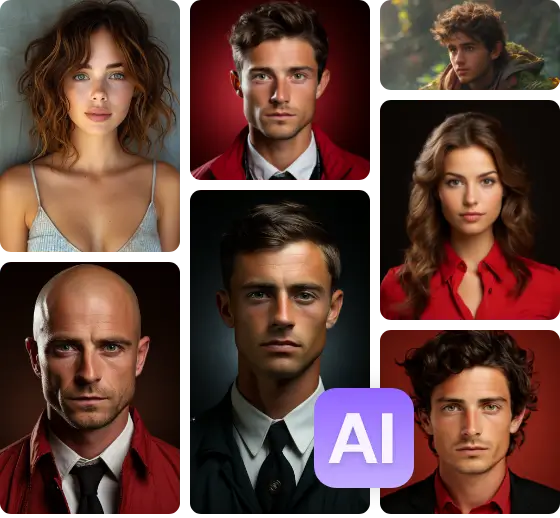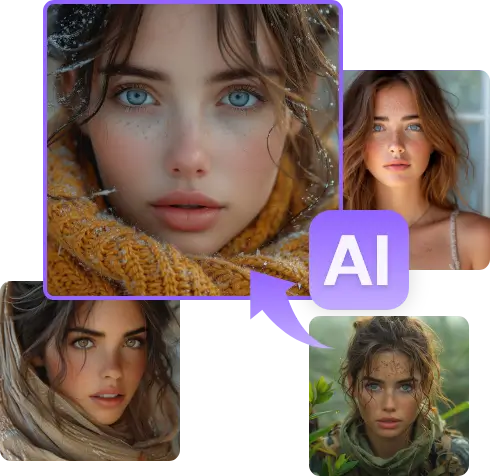Unlocking the Secrets of AI Face Generator: A Comprehensive Guide
Welcome to the fascinating world of AI Face Generator! In this guide, we’ll delve into the basics of what AI Face Generator is all about and how it works. Whether you’re a professionals, or just someone intrigued by the wonders of artificial intelligence, this guide is for you.
Introduction to AI Face Generator
Let’s start with the basics. An AI Face Generator is like a smart computer program. It uses artificial intelligence (AI) to make realistic human faces from nothing. These faces can look very real, almost like they’re real people.
In a world where technology is advancing quickly, artificial intelligence (AI) is making big changes. It’s shaking up many industries and how we do things. One of the coolest things AI can do is create images that look just like ones made by humans. This exciting progress in AI image-making is breaking boundaries, showing new sides of creativity, and pushing what we thought was possible. In this article, we’ll explore the journey of AI image creation and see how smart computers make amazing pictures.
The Evolution of AI in Digital Imagery
Over the past few years, artificial intelligence (AI) has made huge strides in creating images that look real, almost like photographs. This technology has many uses, like in video games, virtual reality, and art.
At first, AI used a simple method called pixel art to make images. Pixel art uses small, blocky dots to create pictures. AI learned to make new pixel art by studying existing images and finding patterns. Though this was just a start, it was important for developing AI-generated images.
As technology got better, AI started using something called generative adversarial networks (GANs). GANs have two parts: a generator and a discriminator. The generator makes new images, and the discriminator checks if they look real. With time, the generator got better at making images that fooled the discriminator. This led to AI making really realistic faces and even selling artwork at auctions. But there are still challenges, like making images that are not just realistic but also new and creative. Despite these challenges, AI’s progress in making images is amazing and could change many industries.
Understanding AI Face Generators
In today’s digital landscape, artificial intelligence (AI) has revolutionized how we create digital characters, particularly through AI face generators. These generators utilize complex algorithms to craft remarkably lifelike human faces that can be found across various platforms, including video games, online profiles, and advertisements. Essentially, they employ AI to generate synthetic faces that closely resemble real photographs.
At the heart of AI face generators are generative adversarial networks (GANs), sophisticated algorithms designed to simulate authentic human features. GANs operate through two main components: the generator and the discriminator, working together to produce images that appear genuine. Through continuous input and refinement, the generator improves its ability to replicate realistic facial expressions and traits.
The Science Behind AI-Generated Faces
AI-generated faces may seem real, but they’re actually the product of advanced technology inspired by how our brains work. One key element behind these creations is neural networks, computer models designed to mimic the human brain’s functions.
A groundbreaking method called generative adversarial networks (GANs) has revolutionized how these faces are made. GANs work like a duel between two artists: one creates fake images, while the other tries to spot the fakes. Through this competition, both networks improve, resulting in incredibly lifelike faces. These systems learn from vast databases of facial images, absorbing the nuances of emotions, textures, and features to create convincing portraits. However, they’re not flawless; occasional imperfections remind us that they’re still computer-generated. Despite this, as technology continues to advance, AI face generators hold promise for diverse applications in fields like healthcare, education, and entertainment.
How AI Face Generators Work
Now, you might be wondering, how does an AI Face Generator create these faces? Well, it all begins with a large dataset of human faces. This dataset serves as the AI’s training material, allowing it to learn the intricate details of facial features, such as eyes, noses, and mouths.
Once the AI has been trained on this data, it can generate new faces by combining different features from the dataset in creative ways. It’s like a digital artist, but instead of paint and canvas, it uses pixels and algorithms to craft its creations.
The Algorithmic Magic: GANs Explained
Generative Adversarial Networks, or GANs, are like creative duos in the world of artificial intelligence. Picture this: one network is the artist, striving to craft realistic images, while the other plays the role of a discerning critic, determining what’s genuine and what’s fabricated. This dynamic interaction pushes both networks to excel, resulting in stunningly authentic images that blur the lines between reality and imagination. Imagine turning a sketch into a lifelike portrait or transforming a mundane scene into a captivating masterpiece – all thanks to the power of GANs.
But how do GANs actually work? Think of them as a tag team – one network, known as the generator, conjures up images, while its counterpart, the discriminator, scrutinizes them for authenticity. With each round of feedback, the generator hones its skills, learning to produce images that even the sharpest critic would find difficult to distinguish from reality. It’s a fascinating dance between creation and critique, ultimately resulting in the synthesis of remarkably convincing visuals. From enhancing photographs to generating entirely new artworks, the possibilities with GANs are as limitless as the imagination itself.
Data and Training: Building a Realistic Face
The first step in creating an AI face generator is to collect an enormous number of face images. Imagine creating an enormous library filled with photographs of faces rather than books. For the AI to learn effectively, these images must be varied, showcasing faces from various ages, ethnicities, and backgrounds.
After gathering the images, the AI starts analyzing and gaining knowledge from them. It examines every tiny element on each face, such as the contours of the eyebrows or the curve of a grin. It’s similar to educating a really intelligent pupil to identify the unique features on every face. Because the AI needs to learn a great deal from all those photographs, this process might take weeks or months at a time and use a lot of computing power.
From Randomness to Realism: The Generation Process
Creating faces using AI is like a game of chance mixed with creativity. Instead of paint and canvas, the AI uses statistics and algorithms to craft photorealistic portraits from scratch. It all begins with some basic traits like age, gender, and facial expression, and then the magic begins.
The AI face generator operates like a massive random number generator, churning out millions of unique faces with each trial. However, not every face is a masterpiece; many end up looking quite peculiar. But here’s where the AI’s learning comes into play.
Through continuous learning and improvement, the AI refines its methods, gradually producing faces that are indistinguishable from real ones. Despite occasional mistakes, such as a crooked nose or an uneven grin, these imperfections add to the charm. Each AI face generator has its own style, much like a human artist, making the process of watching it in action truly fascinating.
Applications of AI Face Generators
AI face generators offer a plethora of applications across diverse industries. Whether it’s crafting virtual influencers for compelling marketing endeavors or crafting lifelike avatars for immersive gaming and virtual reality encounters, these tools are fundamentally altering our interaction with digital content. Their capacity to swiftly and effectively produce realistic images is not just remarkable but also pioneering novel avenues for engaging with technology.
Entertainment and Media
Creating lifelike faces with AI technology has transformed how we produce entertainment and media content. These tools are like magic wands for filmmakers, allowing them to conjure up characters without expensive makeup or casting calls. They’ve also become stars in the realm of digital art, inspiring artists and speeding up the creation of new works.
Moreover, these AI-generated faces aren’t just static images; they can come to life as characters in animations and virtual worlds. This not only sparks imagination but also simplifies the complex process of character design and animation. In essence, AI face generators are reshaping the way we bring stories and art to life, offering new possibilities for creators of all kinds.
Virtual Reality and Gaming
AI face generators are like magic tools in virtual reality (VR) and gaming, making the experience more exciting and real. They help users create their own characters that look just like them, adding a personal touch to their adventures. Whether you’re exploring a virtual world or chatting with friends in a game, these generators make everything feel more immersive and fun.
Imagine being able to design your own avatar for a game or meeting friends in a virtual space where everyone looks real. AI face generators make all of this possible, bringing us closer to a world where our virtual experiences feel just as lifelike as the real thing. With these tools, the possibilities for creativity and connection are endless, making VR and gaming even more enjoyable for people of all ages.
Fashion and Design
Moreover, AI face generators are democratizing the fashion industry by providing accessibility and inclusivity to all. With the ability to generate lifelike faces representing a variety of demographics, designers can create more representative and diverse collections. This not only enhances the overall creativity and innovation within the industry but also promotes a more inclusive and welcoming environment for consumers of all backgrounds.
Security and Anonymity
The emergence of deepfake technology further amplifies security and anonymity concerns, as it enables the seamless integration of AI-generated faces into videos, casting doubt on the authenticity of visual content and its potential misuse.
Despite their potential for creative expression, AI face generators pose significant challenges regarding online security and personal authenticity. As these tools become more accessible, it becomes increasingly crucial to address the ethical implications surrounding their usage. Safeguarding against the misuse of AI-generated faces and deepfake technology requires a concerted effort from both technology developers and users alike to ensure the integrity of digital interactions and uphold trust within online communities.
Ethical Implications
Artificial intelligence face generators offer exciting possibilities for creativity and efficiency in various fields, but they also raise important ethical concerns. While they can spark innovation and streamline processes, there’s a need to address issues like privacy, consent, and potential misuse. It’s crucial for developers, governments, and society to carefully weigh these ethical implications and work towards responsible and equitable use of AI technologies to ensure their positive evolution.
Privacy Concerns with AI Faces
AI face generators have become quite the talk lately. These nifty tools can whip up incredibly realistic human faces, but there’s a catch. They often rely on loads of facial images, making folks worried about privacy. After all, who wants their face floating around without their say-so? And with AI getting better at mimicking real faces, there’s a legit fear that these made-up mugs might be used for shady stuff like stealing identities or crafting fake online personas.
But wait, there’s more! Think about how these AI-generated faces might get caught up in surveillance. Yep, that’s right. With facial recognition tech getting more common, there’s a chance these fake faces could get mixed up with real people. That’s a big problem, ’cause it could lead to all sorts of mix-ups and invade folks’ privacy and freedom.
So, while AI face generators are cool and all, they come with some serious baggage. From privacy worries to potential mix-ups in surveillance, there’s a lot to think about. But hey, maybe with some careful planning and rules in place, we can enjoy the cool stuff without all the drama.
The Debate on Authenticity and Misuse
AI face generators are stirring up debates about whether the faces they create are real or not. These generators can make faces that look incredibly lifelike, but it’s hard to tell if they’re genuine. This makes people wonder how much they can trust what they see online nowadays, especially with so much digital trickery going on.
People are also worried about how easy it is to make and share AI-generated faces. They’re concerned that these faces might be used in ways that aren’t honest or fair. For instance, they could be used to make fake profiles on social media or to spread lies and misinformation. This has led to calls for more openness and responsibility when it comes to making and using AI-generated content.
In light of these concerns, there’s a growing conversation about the importance of transparency and ethics in the world of AI face generators. It’s becoming increasingly clear that we need to think carefully about how these tools are used and regulated. By addressing these issues, we can ensure that AI face generators are used in ways that benefit everyone, without causing harm or deception.
Regulations and Guidelines for Ethical Use
To address worries about AI face generators, people are advocating for rules to control their usage. These rules are meant to make sure that AI-created faces are used correctly and morally, while respecting people’s privacy and rights. One idea is to ask for clear permission from individuals before using their pictures to train AI systems. Another suggestion is to set up strong security measures to prevent data leaks and to establish clear rules for how AI-generated faces can be used ethically.
Furthermore, there’s a demand for more openness about how AI-generated faces are made and applied. This includes revealing the techniques and data used to develop them. By following these rules and guidelines, policymakers aim to find a middle ground between encouraging new ideas and thinking about the moral aspects of AI face generation.
Moreover, there’s a growing call for regulations and guidelines to ensure that AI face generators are used responsibly and ethically. By promoting transparency and accountability, policymakers hope to address concerns about privacy and rights while fostering innovation in this rapidly evolving field.
AI Face Generators for Personal Use
AI face generators tailored for personal use represent a breakthrough in innovation, empowering individuals to craft virtual visages for a multitude of purposes. These cutting-edge tools unlock avenues for boundless creativity and self-expression, offering users an exhilarating journey to experiment with diverse appearances and personas in an entertaining and immersive manner. Whether it’s enhancing social media profiles, creating captivating gaming avatars, or embarking on thrilling digital art endeavors, AI face generators present an effortless and captivating means to tailor one’s online identity with flair and finesse.
Apps and Tools for Creating AI Faces
In the contemporary digital era, AI face generators are gaining traction among those seeking to express their creativity or improve their online visibility. These advanced applications utilize artificial intelligence algorithms to produce realistic faces that users can personalize to your liking.
Canva
Create realistic human faces effortlessly with Canva’s free AI face generator. Customize features such as age, gender, and facial expressions to generate unique faces in just a few clicks. Whether you need avatars for your social media profiles or characters for your projects, Canva’s AI face generator has got you covered.
Fotor
Fotor’s AI face generator is your go-to tool for creating lifelike human faces from text or photos within seconds. With easy-to-use customization options, you can tweak facial features and styles to suit your preferences. Whether you’re a designer, gamer, or content creator, Fotor’s AI face generator offers endless possibilities for bringing your ideas to life.
Picsart
Unleash your creativity with Picsart’s AI face generator, allowing you to instantly generate unique portraits and realistic faces. Whether you’re designing graphics, editing photos, or crafting digital art, Picsart’s intuitive tool offers a seamless experience for meeting your creative needs.
Generated Photos
Customize your own faces using Generated Photos’ AI face generator, offering options to adjust age, pose, skin tone, and emotion. Whether you’re looking to create a baby’s innocent face or an adult’s confident expression, Generated Photos’ easy-to-use interface allows you to craft the perfect face for your projects.
ZMO.AI
Transform images into lifelike faces with ZMO.AI’s face generator. Simply upload a photo and let the AI work its magic to emulate the person’s features. Whether you’re creating avatars or experimenting with digital art, ZMO.AI’s intuitive platform makes face generation a breeze.
Unreal Person
Unreal Person’s AI image creator generates unique faces that don’t exist, leveraging billions of human faces for inspiration. Whether you need fresh faces for gaming, animation, or virtual reality, Unreal Person offers a diverse range of AI-generated faces to suit your needs.
Gooey.AI
Explore Gooey.AI’s innovative face extraction and AI-generated photo generator for your creative projects. Whether you’re creating animations or adding voices to characters, Gooey.AI’s versatile tools offer endless possibilities for bringing your ideas to life in the digital realm.
Creative and Personal Projects
Artificial intelligence (AI) has revolutionized how we create and share images of faces online. These AI face generators are like magic tools that let people design faces for various purposes, from digital art to social media profile pictures. It’s like having a digital artist at your fingertips, helping you express yourself in unique ways.
For artists and designers, AI face generators are like a well of inspiration. They can blend these AI-generated faces with other elements to create stunning artworks that break the mold of traditional art. It’s a whole new world of possibilities, where imagination knows no bounds and creativity flourishes.
Beyond the realm of art, AI face generators offer a shield of anonymity for internet users. Whether you’re gaming online or chatting on social media, these generated faces let you keep your real identity hidden. It’s like wearing a mask in the digital world, giving you the freedom to interact without revealing who you truly are.
Educational Applications of AI Face Generation
Artificial intelligence face generators aren’t just for fun or art – they’re becoming valuable tools in education too. Teachers can use them to show how computers learn to make lifelike faces, teaching students about complex topics like deep learning and neural networks.
By letting students experiment with these generators, they can learn hands-on about things like data manipulation and image creation. It’s a practical way to grasp concepts that might otherwise seem abstract or difficult.
Moreover, these generators aren’t limited to computer science classes. They can be part of projects that blend different subjects like psychology, sociology, and ethics. This helps students think critically about the impact of AI on identity and society, preparing them for the ethical challenges of the future.
The Impact on Social Media
The impact of AI face generators on social media is significant. These tools are changing the way people present themselves online, offering new opportunities for creativity and self-expression. However, they also bring challenges regarding authenticity and privacy that need to be addressed.
AI Faces and Online Identities
Social media has become an essential part of our lives, letting us connect with friends and share our stories easily. But now, there’s a new twist with artificial intelligence face generators. These tools let us create realistic-looking faces that aren’t real people. So, we can make online identities that might not really match who we are.
These AI face generators bring both good and bad things for social media users. They’re great for expressing ourselves and trying out different looks online. Some people like that they can stay private while still being active online. But, there’s also concern about people using these tools to trick others or spread harmful ideas. It’s a balancing act between fun and responsibility in the digital world.
Challenges and Opportunities for Social Media
Artificial intelligence face generators are shaking up social media, offering both opportunities and challenges for users and platforms alike. These tools promise to jazz up our online presence, sparking creativity and making our feeds more eye-catching. Yet, they also open the door to deception, with fake profiles and synthetic personas threatening trust and fueling online mischief like trolling and spreading fake news. This poses a tough task for social media developers and moderators, who must find ways to foster creativity while safeguarding users from harm. Balancing freedom of expression with protection from abuse is key in navigating this new digital landscape.
The Future of Digital Interactions
The future of how we connect online is taking a new turn with the rise of AI face generation. These clever tools are getting better and easier to use, which means we’ll likely see more virtual faces popping up on our screens. This might change how we chat and share online, making it hard to tell what’s real and what’s not. But it’s not just about social media – AI faces could shake up other parts of our digital world too. Think about video games, movies, and online shops. We might start seeing virtual stars and models everywhere, which could change how companies sell us stuff. But as we dive into this new digital world, we’ve got to keep an eye on the ethics. It’s important to use these virtual faces in ways that are fair and open to everyone.
Conclusion: The Future of AI Face Generation
The future of AI face generation holds promise for revolutionizing digital interactions. With continued advancements in technology, we can expect to see even more realistic and versatile virtual faces. However…
Summarizing the Potential and Pitfalls
AI face makers could change how we use the internet to describe ourselves. With these tools, we can make up fake faces that aren’t real people. This lets us try out different looks and names more easily. But they also make you think about how honest and trustworthy people are on social media. AI face makers can be fun, but we need to be aware of how they might affect privacy and validity. You should find a way to use these tools to be creative while also making sure they don’t hurt anyone. As technology gets better, we need to keep asking ourselves how we can use AI face generation to shape our digital identities and relationships.
The Ongoing Evolution of AI in Imagery
Every day, new breakthroughs in artificial intelligence imaging are emerging, rapidly expanding the field. These advancements are not only transforming digital art but also pushing the boundaries of what technology can achieve. With AI algorithms creating lifelike portraits and altering landscapes, the possibilities seem endless. As researchers strive to improve these technologies and address ethical concerns, we can expect even more remarkable developments in the future.
Final Thoughts on the Impact of AI Face Generators
AI-powered face generators are changing the way we interact online. These tools offer exciting possibilities for creativity and self-expression, allowing users to experiment with different looks and identities. However, they also raise concerns about privacy and authenticity. It’s important to approach these technologies with a critical mindset and ethical considerations. By embracing the opportunities while mitigating the risks, we can foster a more diverse and welcoming online environment for everyone.









